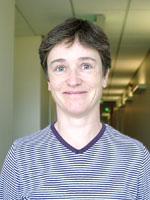
Frances A. Houle
IBM Almaden Research Center
Fountain of Intellectual Youth
When I began work in 1980 at the lab that is now IBM’s Almaden Research Center, I was asked to consider how to study reaction mechanisms important to the formation and processing of materials for semiconductor chips. The industry was in transition: manufacturing processes were shifting from the use of various liquid solutions to all-dry processes stimulated by radiation and charged particles, and there was little understanding of how any of it worked at a fundamental level. Physicists and electrical engineers were making good progress in developing the processes used for making chips without much formal chemistry training. At the same time the electronics industry began hiring chemists to work in R&D and manufacturing, and we began to delve into the very new chemistry of these processes.
Working in an interdisciplinary environment was excit-ing and challenging, but we chemists were quite isolated. We grew adept at speaking the language of our physics and engineering colleagues, but we knew few with whom we could talk about the chemistry we found so interesting. Academic departments of chemistry and chemical engineering and the major scientific societies were focused mainly on traditional fields, so there was no forum at which to present our papers and discuss our work. In response to this situation Len Interrante (then at General Electric and now at Rensselaer Polytechnic Institute) and the late Bruce Scott (of IBM’s Thomas J. Watson Research Center) had the idea to start a Gordon Conference for chemists working in the electronics industry.
The first meeting of the Chemistry of Electronic Ma-terials GRC was held in Santa Barbara, California, in the winter of 1985. The conference was tremendously broad and interesting, covering topics from photolithography to surface science. I vividly remember sitting in the back of the room, looking around at the audience, and marveling that there were so many of us there. I saw a lot of chemists happy to talk with one another, but I wondered if our shared training alone would suffice to sustain the conference. In subsequent meetings the conference chairs and steering committees worked hard to define who the conference should serve and to build a community of attendees who identified themselves as electronic materials chemistry researchers. Over time the conference has become a multidisciplinary, vibrant meeting, bringing together people from universities, national laboratories, and industrial research centers worldwide and addressing a variety of emerging themes.
I have no doubt that the GRC organization has been central to the establishment of the field of electronic materials chemistry. The conference’s attendees and speakers over the years constitute a “who’s who” of the field’s major contributors. Organizers of meetings sponsored by scientific societies now regularly hold sessions on aspects of electronic materials chemistry, and many academic departments have materials chemists among their faculty. I chaired the 1994 conference and attended the conferences until 1999, when my own research took me deeply into photolithography. Interestingly, photo-lithography is not a major focus of the contemporary Chemistry of Electronic Materials Conference despite having been on the program of the first meeting. Since then I have been attending nanofabrication conferences, including the Nanostructure Fabrication GRC.
The Chemistry of Electronic Materials is an example of a Gordon Conference founded by industrial chemists who needed a venue to discuss the leading-edge topics in their field. But Gordon Conferences play a much broader role in the overall vitality of industrial research. Unlike that of university labs, the staffing of industrial labs tends to be rather stable, with only a few new people coming in each year. This stability promotes efficient teamwork among experienced professionals with backgrounds in many disciplines, but it does little to bring new perspectives to the laboratory. The agenda of the typical conference attended by industrial chemists is usually rushed and packed, with very short talks. This format is great for the transfer of information but provides neither the time or space for the reflection and discussion crucial in innovative science nor the opportunity to meet new people and start new collaborations. Gordon Conferences, however, provide a forum to slow down and focus on new research, learn about areas of science not represented by our own institutions, and think broadly and imaginatively. In other words, GRC is a fountain of intellectual youth.